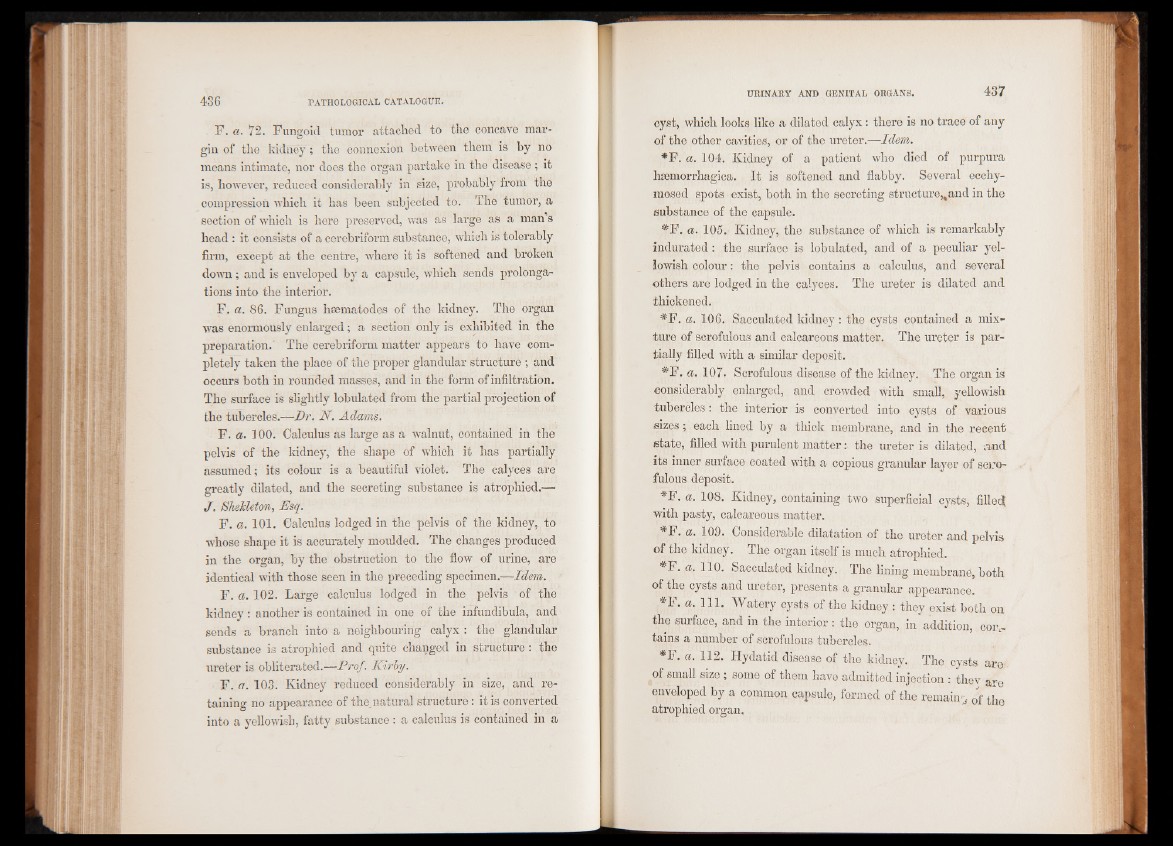
F. a. 72. Fungoid tumor attached to the concave margin
of the kidney; the connexion between them is by no
means intimate, nor does the organ partake in the disease ; it
is, however, reduced considerably in size, probably from the
compression which it has been subjected to. The tumor, a
section of which is here preserved, was as large as a man’s
head : it consists of a cerebriform substance, which is tolerably
firm, except at the centre, where it is softened and broken
down ; and is enveloped by a capsule, which sends prolongations
into the interior.
F. a. 86. Fungus hsematodes of the kidney. The organ
was enormously enlarged; a section only is exhibited in the
preparation. The cerebriform matter appears to have completely
taken the place of the proper glandular structure ; and
occurs both in rounded masses, and in the form of infiltration.
The surface is slightly lobulated from the partial projection of
the tubercles.—Dr. N. Adams.
F. a. 100. Calculus as large as a walnut, contained in the
pelvis of the kidney, the shape of which it has partially
assumed; its colour is a beautiful violet. The calyces are
greatly dilated, and the secreting substance is atrophied.—>
J. Shekleton, Esq.
F. a. 101. Calculus lodged in the pelvis of the kidney, to
whose shape it is accurately moulded. The changes produced
in the organ, by the obstruction to the flow of urine, are
identical with those seen in the preceding specimen.—Idem.
F. a. 102. Large calculus lodged in the pelvis of the
kidney : another is contained in one of the infundibula, and
sends a branch into a neighbouring calyx : the glandular
substance is atrophied and quite changed in structure: the
ureter is obliterated.—Prof. Kirby.
F. a. 103. Kidney reduced considerably in size, and retaining
no appearance of the.natural structure: it is converted
into a yellowish, fatty substance : a calculus is contained in a
cyst, which looks like a dilated calyx: there is no trace of any
of the other cavities, or of the ureter.—Idem.
*F. a. 104. Kidney of a patient who died of purpura
hsemorrhagica. It is softened and flabby. Several ecchy-
mosed spots exist, both in the secreting structure,%and in the
substance of the capsule.
#F. a. 105. Kidney, the substance of which is remarkably
indurated: the surface is lobulated, and of a peculiar yellowish
colour: the pelvis contains a calculus, and several
others are lodged in the calyces. The ureter is dilated and
thickened.
*F. a. 106. Sacculated kidney: the cysts contained a mixture
of scrofulous and calcareous matter. The ureter is partially
filled with a similar deposit.
*F. a. 107. Scrofulous disease of the kidney. The organ is
considerably enlarged, and crowded with small, yellowish
tubercles: the interior is converted into cysts of various
sizes; each lined by a thick membrane, and in the recent
state, filled with purulent matter: the ureter is dilated, and
its inner surface coated with a copious granular layer of scrofulous
deposit.
*F. a. 108. Kidney, containing two superficial cysts, filled,
with pasty, calcareous matter.
#F. a. 109. Considerable dilatation of the ureter and pelvis
of the kidney. The organ itself is much atrophied.
*F- a- HO. Sacculated kidney. The lining membrane, both
of the cysts and ureter, presents a granular appearance.
*1. a. 111. Watery cysts of the kidney : they exist both on
the surface, and in the interior : the organ, in addition, cor4-
tains a number of scrofulous tubercles.
*F. a. 112. Hydatid disease of the kidney. The cysts are
jOf small size ; some of them have admitted injection : thev ar.e
enveloped by a common capsule, formed of the remain-. M
atrophied organ, 6